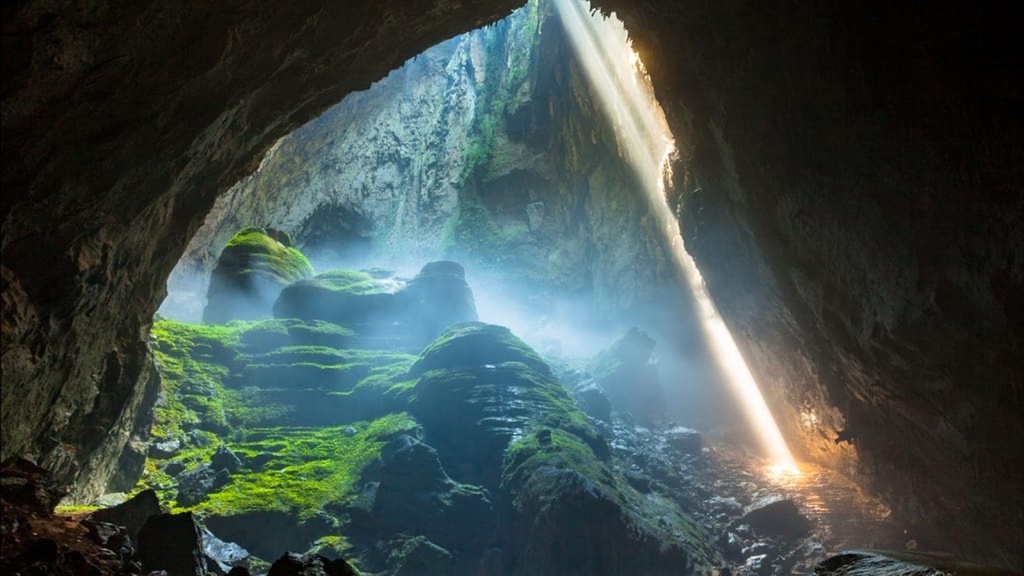
Hidden in the heart of central Vietnam lies one of Earth’s most extraordinary natural wonders: Son Doong Cave, the world’s largest cave, a place so vast it has its own jungle, weather system, and towering limestone walls.
Since its discovery, Son Doong has captivated global media—from National Geographic and BBC to CNN and travel giants like Tripadvisor and Lonely Planet. For adventure seekers, it’s become the ultimate bucket-list experience.
Where is Son Doong Cave?
Son Doong Cave sits at 17°55’N and 106°14’E, in Son Trach commune, Bo Trach district, Quang Binh province. It lies within the core zone of Phong Nha-Ke Bang National Park, a UNESCO World Heritage Site renowned for its dramatic karst landscapes.
The cave is close to Vietnam’s border with Laos, nestled amid the limestone mountains that have been sculpted over millions of years by underground rivers and shifting tectonic forces.
The Birth of a Giant
Formed 2–5 million years ago, Son Doong began when underground rivers eroded limestone along fault lines, carving a massive tunnel beneath the mountains. Over time, portions of the cave ceiling collapsed, creating gigantic skylights known as sinkholes, letting sunlight pour in and giving rise to hidden rainforests inside the cave itself.
Son Doong’s mind-boggling size measures:
- Width: up to 150 meters
- Height: over 200 meters
- Length: nearly 9 km
- Volume: an estimated 38.5 million cubic meters—enough to fit 15,000 Olympic swimming pools!
Who Discovered Son Doong Cave?
Son Doong might have remained a secret if not for local jungle man Ho Khanh. In the early 1990s, while seeking shelter from a sudden storm in Phong Nha’s jungle, he stumbled upon a massive cave opening shrouded in mist. The roaring wind and the darkness inside were so intimidating that he didn’t dare explore further.
Years later, in 2007, a British expedition led by Howard Limbert returned to Vietnam to survey new caves. Ho Khanh tried guiding them back to the mysterious cave but couldn’t relocate it. Encouraged by Limbert to keep searching, Ho Khanh persisted and finally rediscovered Son Doong in 2008.
In 2009, the British Cave Research Association conducted the first full survey, confirming Son Doong as the world’s largest cave.
Why Son Doong Cave Matters
Son Doong isn’t merely big—it’s a geological and ecological marvel. When news of its size and unique ecosystem broke, it stunned the global scientific community and adventurers alike. Since adventure tours began in 2013, Son Doong has become a flagship destination, showcasing Vietnam’s natural wonders to the world.
The Name “Son Doong”
Originally, the cave was known by Ho Khanh’s name. However, explorers later renamed it Hang Son Doong, meaning “Mountain River Cave.” The name reflects its location in the Doong Valley near an ethnic village called Doong, with “Son” meaning mountain and “Doong” relating to the valley’s name.
Highlights Inside Son Doong Cave
The Vietnam Wall
At the cave’s far end rises the Vietnam Wall, a monumental stalactite barrier about 90 meters high. Climbing it requires ropes and safety equipment provided by expert guides. Reaching its summit rewards you with views of the cave’s exit and a sense of triumph few places on Earth can match.
Underground Campsites
A Son Doong expedition includes three nights of camping—one in Hang En Cave and two inside Son Doong itself. The cave’s sandy floors host two beautiful campsites near the sinkholes. Imagine waking up to shafts of sunlight streaming through jungle canopies inside a cave—a truly surreal experience.
The Dog’s Paw
One of Son Doong’s iconic landmarks is a colossal stalactite formation nicknamed Dog’s Paw. From this vantage point, you can take in panoramic views of the cave’s immense chambers.
Son Doong’s Sinkholes
Son Doong has two massive sinkholes, natural skylights allowing sunlight to nourish lush rainforests inside the cave.
- Sinkhole 1 (known as Vong Dinosaur) features the famed “Wedding Cake” stalactite, a spectacular layered formation.
- Sinkhole 2, often called the “Garden of Eden,” is a thriving green oasis, complete with towering trees and rare plants, all nurtured by the cave’s unique microclimate.
A Cave With Its Own Weather
Son Doong’s vast chambers create their own climate. Moisture from underground rivers condenses into clouds that drift and swirl within the cave, producing surreal, mist-filled vistas perfect for photography.
The Son Doong Cave Tours
Access to Son Doong Cave is tightly controlled to preserve its fragile ecosystem. Only about 1,000 visitors per year are permitted. Tours are operated exclusively by Oxalis Adventure under the supervision of Quang Binh authorities.
4 Days / 3 Nights Tour
- Price: ~$3,000 per person
- Includes trekking, caving, camping, and full guiding support.
6 Days / 5 Nights Tour
Day 1: Arrival and safety briefing at Phong Nha.
Day 2: Trek to Ban Doong Village and Hang En Cave.
Day 3: Enter Son Doong, camp at Sinkhole 1.
Day 4: Explore deeper, camp at Sinkhole 2 (Garden of Eden).
Day 5: Climb the Vietnam Wall, exit the cave, transfer to Chay Lap Farmstay.
Day 6: Return to Dong Hoi for departure.
Important: Independent visits are not allowed—you must join an official tour for safety and conservation reasons.
Why Visit Son Doong Cave?
Exploring Son Doong isn’t just a physical challenge—it’s a journey into an alien world of natural wonders. It’s one of the few places left on Earth where humans can still discover hidden corners unseen for millions of years.
Son Doong stands as a powerful symbol of Vietnam’s natural heritage and a testament to the spirit of discovery. If you’re searching for the ultimate adventure, this cave awaits.



